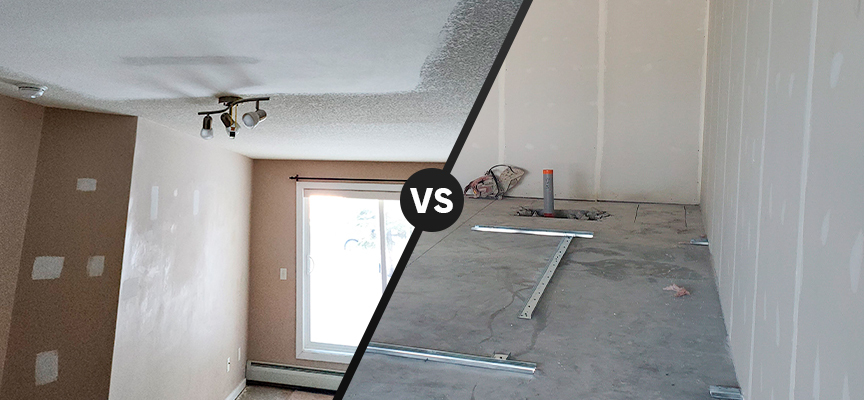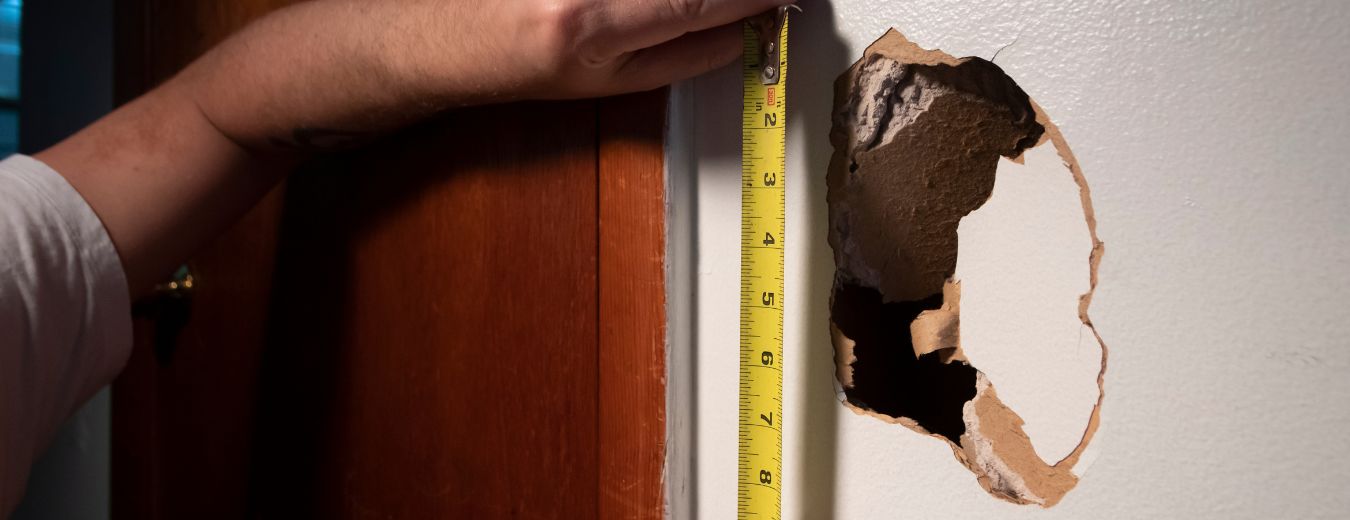Step-by-Step Approaches to Getting Flawless Drywall Repair Work and Installment
Achieving perfect drywall fixing and installation needs a systematic technique. It entails comprehending the various sorts of drywall and the tools essential for the task. Appropriate location preparation is vital prior to starting any type of work. drywall contractors. Each action, from patching holes to mounting new sheets, demands interest to information. The process doesn't end with installment; finishing techniques are essential for a polished appearance. The next actions will assure a seamless outcome, but what precisely do they require?
Understanding Drywall Kind and Tools Needed

The installation tools are similarly vital. An utility blade is vital for reducing drywall sheets, while a drywall saw can aid in making precise cuts for fixtures or outlets. T-squares guarantee precise measurements, and drywall screws or nails secure the panels to wall surface studs. In addition, a drywall lift can help with the installment of huge sheets, minimizing physical strain. Familiarity with these types and tools substantially adds to the effectiveness and high quality of drywall tasks.
Preparing the Location for Repair Service or Installment
Preparing the location for drywall repair service or installment is crucial to assure a smooth and reliable procedure. First, the surrounding area ought to be free from furniture and other obstacles to provide ample working room. This not just ensures security however additionally protects against damages to possessions. Next, it is vital to cover the flooring with ground cloth to capture any kind of particles or dust created during the work.
Furthermore, the walls need to be checked for any type of loose paint or wallpaper that might hinder bond. Eliminating these elements develops a clean surface area for the brand-new drywall. Before beginning, it is advisable to transform off power to electric outlets or components around. Making sure appropriate illumination in the work space will certainly additionally improve exposure and focus during the repair work or installation procedure. Interior Painting. By thoroughly preparing the location, one lays the groundwork for an effective drywall project
Step-by-Step Refine for Patching Holes

Covering holes in drywall needs a systematic technique to guarantee a seamless repair. The very first step involves evaluating the size of the hole. For tiny holes, a patching substance may be adequate, while larger openings require a spot. Next off, the damaged area must be cleaned up and prepared by eliminating any kind of loosened debris.
For small holes, applying spackling compound with a putty knife is recommended, smoothing it over the opening and feathering the sides. When completely dry, sanding the location guarantees a smooth coating. For bigger holes, a drywall spot need to be reduced to size, positioned over the opening, and protected with screws. After installing the spot, the exact same spackling process is duplicated, complied with by sanding.
Finally, the patched location needs to be primed and painted to match the bordering wall. This thorough procedure guarantees an expert appearance and extends the lifespan of the repair work.
Mounting New Drywall Sheets: A Comprehensive Overview
Installing brand-new drywall sheets calls for careful planning and execution to assure a visually enticing and sturdy finish. First, the location has to be measured properly to determine the number of sheets needed. It is essential to select the appropriate thickness, usually 1/2-inch for interior wall surfaces and 5/8-inch for ceilings or fire-rated applications.
Next, the studs or structure should be checked for any irregularities, making certain they are straightened and effectively spaced. When positioning the drywall sheets, they should be positioned flat to decrease seams and enhance structural integrity. A drywall lift can be useful for above setups.
Securing the sheets with drywall screws at proper intervals ensures a safe and secure installation. It is necessary to countersink the screws a little below the surface area to plan for the finishing process. Adhering to these standards will result in a strong structure, all set for the following actions in drywall finishing.
Completing Touches: Insulation, Mudding, and Fining Sand Techniques
Once the drywall sheets are safely secured, the emphasis changes to the complements that will offer a refined appearance. This process starts with taping, making use of either paper or fiberglass harmonize tape to cover the joints in between sheets. The tape assures a smooth change, decreasing the danger of splitting. Adhering to insulation, mudding is essential; a joint substance is used over the tape to load voids and develop a smooth surface area. Typically, numerous layers are necessary, every one feathery out additionally than the before minimize exposure.
After enough drying out time, fining sand is the last action in accomplishing a flawless surface. A fine-grit sandpaper is used to smooth the dried compound, guaranteeing there are no bumps or flaws. Interest to information during this stage is considerable, as it considerably influences the overall appearance of the wall. Completion result need to be an also, professional-looking surface area all set for priming and paint.
Frequently Asked Questions
How Do I Choose the Right Drywall Density for My Task?
To pick the appropriate drywall density, consider the project's objective, place, and structural demands. Standard densities include 1/2-inch for basic use and 5/8-inch for fire-rated applications, ensuring toughness and compliance with building regulations.
:strip_icc()/how-to-patch-drywall-gray-wall-aadf75af0f5d4ec19704a770bd84efc2.jpg)
Can I Install Drywall Over Existing Drywall?
Yes, installing drywall over existing drywall is feasible. Nonetheless, it is important to assure the underlying surface is free and safe and secure from damage. Appropriate fastening and factor to consider of density are imperative for an effective setup.
What Are the very best Practices for Drywall Disposal?
The most effective techniques for drywall disposal consist of recycling when feasible, using regional waste management solutions, and complying with standards for unsafe products if appropriate. Interior Painting. Correctly securing and identifying waste guarantees conformity and safety throughout disposal
The length of time Should I Wait On Mud to Dry Prior To Fining sand?
Generally, one must wait 1 day for drywall mud to completely dry before fining sand. Drying time can vary based on moisture and temperature, so inspecting for a firm structure is suggested prior to continuing.
Exist Eco-Friendly Drywall Options Available?
Yes, environmentally friendly drywall alternatives are readily available. These choices frequently use recycled products, low-VOC adhesives, and lasting manufacturing methods, lowering ecological impact while giving more info efficient insulation and durability for numerous building and improvement jobs.
An energy knife is essential for cutting drywall sheets, while a drywall saw can aid in making accurate cuts for components or outlets. Preparing the location for drywall repair or installment is vital to ensure a smooth and efficient process. Covering openings in drywall needs an organized method to assure a seamless repair service. Installing new drywall sheets calls for careful preparation and implementation to guarantee a tough and visually attractive coating. Yes, setting up drywall over existing drywall is possible.